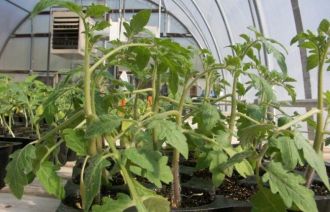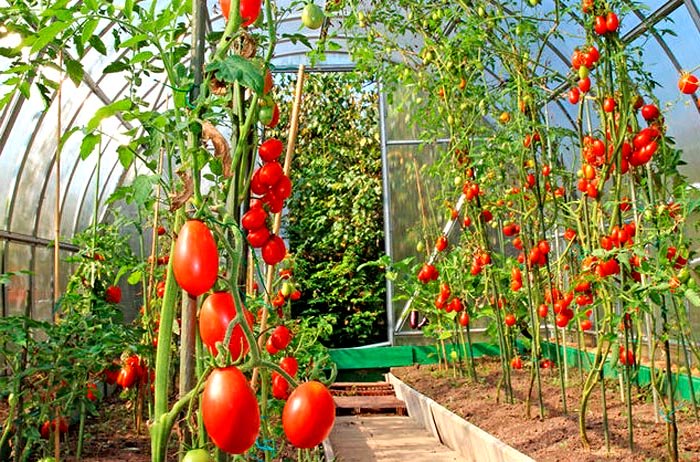 Every gardener dreams of receiving fresh vegetables and fruits all year round. Greenhouse growing of plants allows not only to provide your family with useful trace elements, but also can become a source of a fairly profitable business.
Every gardener dreams of receiving fresh vegetables and fruits all year round. Greenhouse growing of plants allows not only to provide your family with useful trace elements, but also can become a source of a fairly profitable business.
We will talk about how to grow healthy and tasty tomatoes in a greenhouse. 15-20 days after planting, the plants should already be tied up. The garter is carried out by everyone in their own way. It is possible to the stakes that are driven in during the planting of seedlings, it is possible to the trellis, that is, they stretch the wire at the top of the greenhouse and tie each plant at the bottom of the stem. You can tie up tomatoes in a greenhouse by analogy with cucumbers. But unlike cucumber garters, tomatoes tie each plant with a separate piece of twine. The plant is tied to a vertical piece of twine in several places as it grows.
The formation of tomatoes in the greenhouse is carried out in one stem so that the plant has about 7-8 brushes with the beginnings of flowers. It is allowed to leave one stepson below, having one flower brush. All others that appear in the axils of the leaves should be removed. In this case, the removal is carried out when the stepchildren grow to a length of no more than 8 cm. In order not to bring viral diseases from one plant to everything, you need to know how to stepson tomatoes in a greenhouse. Stepson plants early in the morning, at this time they break off more easily. It is recommended to break it off, grabbing the stepson and moving the fingers to the side, trying not to get the tomato juice on gloves or fingers, because all plants become infected this way if one of them was sick. Otherwise, after the stepsons on one bush are removed, you will have to wash your hands and proceed to stepson the next plant. It is advisable to leave stepchildren's stumps in the sinuses 2-3 cm high.
It is important to know, having planted tomatoes in a greenhouse, how to care for them throughout the summer season.
Prefabricated polycarbonate greenhouses, as a rule, do not have vents that could be opened in hot weather and give access to various flying insects, so there are problems with tomato pollination. You have to do it manually by the owners themselves. Pollination is carried out in dry, clear weather, by lightly shaking the flowering tomato brushes. In order for pollination to end with the ovary, it is necessary to spray flowering plants from a fine sprayer directly on the flowers or shed the soil. It is important that the pollen is not dry, and therefore create a humid environment. After 2-3 hours, it is necessary to open all windows, doors or vents, if any. Such measures will reduce the humidity of the air. The greenhouse in the hot season should be constantly ventilated.
As we know, high constant humidity is detrimental to tomatoes. Excess water in the soil leads to a decrease in the sugar content of the fruit, as a result of which the tomatoes become sour in taste and watery. In general, tomatoes do not like abundant watering, even in a greenhouse, even in open ground. From excess water, the fruits may begin to burst. Before flowering, tomatoes in the greenhouse are watered once a week, spending 5 liters per 1 square meter. During flowering, watering is increased by 2-3 times. Moreover, tomatoes should be watered with warm settled water at a temperature of + 20-22 degrees. In greenhouses where there is not sufficient ventilation, it is recommended to water in the morning, since evening watering contributes to the formation of strong condensate, which, at low night ambient temperatures, adversely affects plants, causing various diseases.
Tomatoes need to be fed several times throughout the summer season.
The first top dressing is given to plants for about three weeks after they are planted in a greenhouse or in open ground. For top dressing, you need to prepare a solution consisting of mullein and water, in a ratio of 10: 0.5 (where 10 is water, 0.5 mullein). In the absence of manure, Ideal liquid fertilizer is used, diluted according to the instructions. Each plant is shed under the root, at the rate of one liter per bush.
The next top dressing is carried out after two weeks. Here, as Oktyabrina Ganichkina advises, liquid fertilizer Fertility or similar is taken per 10 liters of water, plus 1 teaspoon of potassium sulfate is added to this. Watered at the rate of 5 liters per 1 sq. meter. The third time, tomatoes are fed for fruit ripening with superphosphate and wood ash in the following proportion - 1 tbsp. spoon of superphosphate + 2 tablespoons of wood ash. Or replace with ready-made fertilizer for tomatoes, peppers, eggplant. Water 2 liters for each plant.
Comments on this post are no longer accepted.